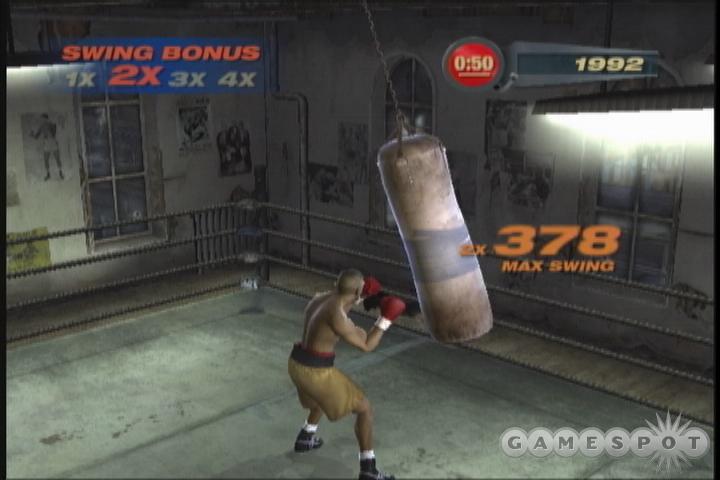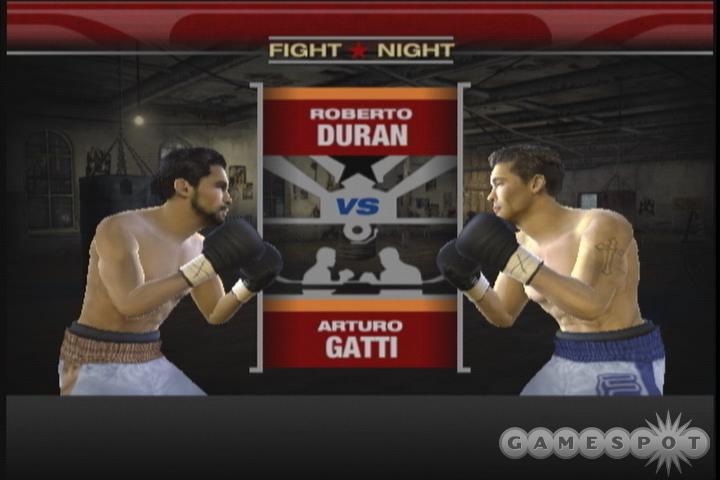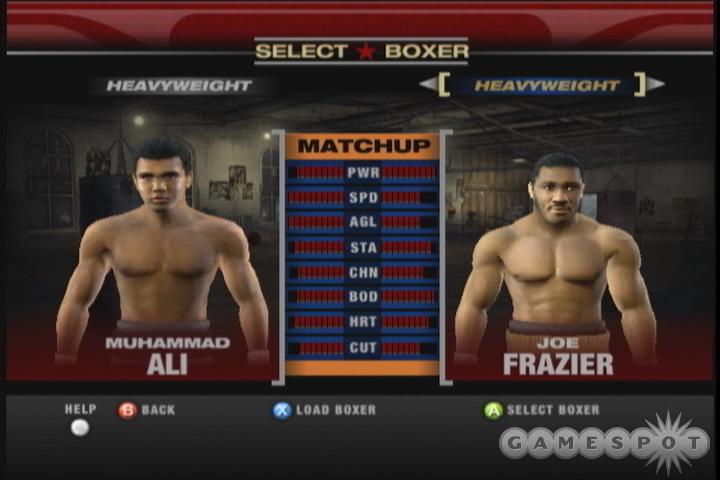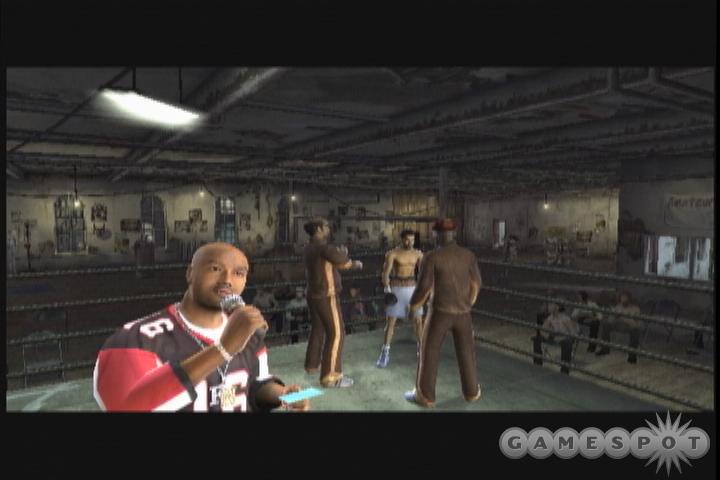Over the years, the boxing genre has been trying to get more and more realistic, but most attempts to date have fallen flat in one category or another. Electronic Arts has made several good attempts with its Knockout Kings series, but even here some aspects of the games weren't as real as they could have been--and perhaps should have been. This year, EA Sports did to its boxing game what it did last year to its baseball games--it started over. The end result is Fight Night 2004, an all-new game with an all-new name. And much how MVP Baseball made improvements to EA's then-stagnant baseball series, Fight Night 2004 reinvigorates the boxing genre. It also offers the most realistic control, gameplay, and graphics that the genre has ever seen.

Fight Night 2004 comes in three different flavors: exhibition, career, and (exclusively on the PlayStation 2) online. Exhibition allows you to quickly pick a fighter to go up against a computer-controlled opponent or a second player. Career mode starts you out with a fighter at the beginning of his career. Therefore, he has no wins, no losses, and no talent. Your fighter's physical attributes in career mode are set to zero, whether he's a boxer you created by using the game's create-a-boxer utility or he's one of the licensed boxers included in the game. To get started, you're given a set amount of physical attribute points to distribute across eight categories, such as punching power and agility. As you might expect, each of the attribute categories directly corresponds to your boxer's performance in the ring. To increase your fighter's ability, you're given an opportunity before every bout to train your fighter.
The training sessions are represented by four different minigames that are based on actual boxing exercises, like punching hand mitts, working the heavy bag, punching a combo dummy, and sparring with a computer-controlled opponent. The minigames test your memory, timing, and reflexes, but more importantly, they teach you how to play the game. Doing well in the minigames earns you 15 attribute points, while doing poorly results in fewer attribute points. Whatever you earn can be applied to two specific performance categories. Since each training session is tied to two specific categories, the game forces you to become proficient at each one to build a fighter who has good ratings in each performance category. While forcing you to do anything doesn't necessarily sound like a good way to design a game, in this case, the repetition brought on by constantly training ensures that you're making the most of the opportunity. Furthermore, it teaches you how to play the game properly, thus making the actual boxing more enjoyable.
Aside from training and fighting, the career mode also includes other duties, like picking your next opponent, checking out the awards your fighter has earned, and purchasing goods, like new trunks. While picking your next opponent may sound like a trivial menu selection, there is a bit of strategy involved. First, you'll want to figure out who you have to choose from, which typically ranges from two to six fighters. Second, you'll want to check out their stats to see what they're ranked and how their attributes stack up against your fighter's attributes. Once you've scouted your options, the decision usually comes down to whether you're willing to risk a loss against a more skilled fighter for a shot at his higher rank versus whether or not you're willing to fight an easier opponent to build up your fighter's attribute points before trying to climb the ranks any further. Making the right choice when choosing an opponent can honestly mean the difference between a win and a loss.
The only real negative aspect of Fight Night 2004's career mode is that it forces you to retire at the age of 40, which is really quite anticlimactic. This, along with the fact that the training becomes a moot point once you've maxed out you're fighter's abilities, seems to be a bit of a waste, since it would have been interesting to see how long you could remain a contender with a fighter whose abilities faltered with time. While the career mode has some nice touches to it, the abrupt ending robs it of attaining the level of strategy that, say, a great franchise mode in a football game might have. Ultimately, it's only a little bit more than just a string of fights with a running total of your wins and losses.
On the PlayStation 2, you also have the ability to play online to box against others to see who the real world champion is. The game's online mode is straightforward and offers you the ability to choose from different divisions based on weight classes. The online play works well, supports USB headsets for voice chat, and gives the game the replay value you'd expect from a competitive online offering. It'll keep you busy long after you've grown bored of fighting the game's computer-controlled opponents.
The roster of 32 licensed boxers included in the game spans six weight divisions that range from featherweight to heavyweight. The impressive lineup of fighters mostly consists of recent champions, such as Marco Antonio Barrera, Erik Morales, Felix Trinidad, Roy Jones Jr., Bernard Hopkins, Lennox Lewis, Evander Holyfield, and Arturo Gatti. While the majority of the licensed boxers included come from today's era, the game also features a handful of fighters from the past, such as legends Roberto Duran, Muhammad Ali, Joe Frazier, Ray Robinson, Ray Leonard, and Rocky Marciano. While you'll notice some holes in the lineup--for instance, big names like Mike Tyson and George Foreman are nowhere to be found--Fight Night 2004 includes a very easy-to-use and in-depth create-a-fighter mode that can turn out very accurate creations for just about any boxer you could want to put in the game.

While the various modes and options are all well and good, boxing games live and die by their gameplay mechanics. In this respect, Fight Night 2004 has an entirely unique setup. If you want to throw a straight left jab, you press the right analog stick up and slightly to the left. If you want to throw a straight right, you push the right analog stick forward and just to the right. For hooks, you mimic the motion of your fighter's arms with the right analog stick, which is the equivalent of a quarter-circle rotation, left or right. You can also throw uppercuts by moving the right analog stick in a half-circle motion, starting from down to up in either direction for a left- or a right-handed punch. Depressing the right shoulder button (or right trigger) modifies the action on the right analog stick so that you can block or parry incoming punches, but you have to have your arms in the right position for this to be effective.
Meanwhile, the left analog stick handles moving your fighter around the ring, but it can be modified to control upper body movement by pressing the left shoulder button (or trigger). This setup allows you to naturally move around the ring. Moreover, you can bob and weave, and you can throw punches nearly as freely and as fast as real fighters do. Linking combos together is as simple as understanding what works in real boxing and executing these punches in quick succession. While a bit tricky to get used to at the start, once you get a feel for it, you'll wonder why it took so long for someone to make a boxing game that plays this way. Controller-wise, there's no real difference between the PlayStation 2 and Xbox versions of the game, so it all comes down to your own personal preference.
The movement speed of the fighters and the power of their punches have been accurately represented, which delivers great matches--especially since the system implemented for damage and stamina is very realistic. The more punches you throw, the more fatigued your fighter will become, which results in less-powerful punches. This naturally translates into more-realistic fights, since you'll only really want to throw punches when you have an opening. The game does include flash knockdowns (though they happen rarely), which send you to the canvas with one clean punch--no matter how much health your fighter has. These flash knockdowns don't typically upset the balance of the fight too much, but they do make you a bit more cautious and respectful of your opponent's power.

The artificial intelligence of the computer-controlled opponents in the game's normal difficulty setting is just right for newcomers, since it gives you enough of a challenge early on without being too punishing. As you progress through the game's career mode, your opponents naturally become more difficult to fight. Not only do they become faster, punch harder, and block more of your shots, but they actually use ring strategies, like cutting off the ring and moving away when hurt. The depth of the AI in Fight Night 2004 becomes more apparent once you fight your way past the first 40 generic pugilists in career mode to reach the top 10, licensed fighters in the division. You'll see that the fighters actually scrap similarly to the way they do in real life. Chris Byrd moves around the ring more than he throws punches, Felix Trinidad lobs jabs and left hooks from long range, and Muhammad Ali fights, well, like Muhammad Ali. But there is a limit to how good the AI will get, and after becoming completely comfortable with the controls, you'll realize that you just have more options available--like being able to bob out of the way of a punch and being able to come right back in with a straight punch--than the AI will ever use against you.
Fight Night 2004's graphics are pretty outstanding. The models for the fighters are by far the most realistic-looking models used in a boxing game to date. The high-resolution textures and face scans used give the models a lot of detail that you couldn't get otherwise. The work is a bit uneven in spots, though. While Roy Jones Jr. looks spot-on, Evander Holyfield doesn't look quite as photorealistic, for example. The size of the fighters' physical proportions, when compared to one another, is also very accurate. Just pick one of the little guys, like Erik Morales, and stick him in the ring with Lennox Lewis, and you'll see the dramatic differences in size, power, and speed. The animations for the fighters, as they move around the ring and throw punches, are extremely realistic. The knockdowns use a rag-doll physics system that gives the appearance of a fighter who totally loses control of his muscles, which is quite entertaining the first few times you see it. Even after you're well into you're career, you'll have to watch the replays of the good knockdowns (especially if you catch your opponent with a couple of extra punches before he goes down), since they are pretty dramatic-looking.
Whether you're taking damage or dishing it out, the faces of the fighters show the results with bruises, swelling, and cuts. In fact, if a fighter catches a good hard shot to the head while sporting an open cut, you'll see a stream of blood shoot through the air, which is a pretty cool little touch. The collision detection is almost perfect when it comes to the punches, which look as though they are actually connecting with your opponent, even when viewing an up close slow motion replay. You'll see the fighter's face contort, but more importantly, you'll feel the satisfaction and know the difference when you see your opponent's head snap back after you deliver a really good shot. The difference between the graphics of the PlayStation 2 and Xbox versions of Fight Night 2004 is minimal. The lighting and player models look a bit softer on the Xbox, but overall, both versions look almost indistinguishable.

As far as the audio is concerned, the soundtrack included with Fight Night 2004 features a mix of rap and hip-hop artists, including the likes of Puff Daddy, Federation, and David Banner, to name a few. You can create a custom soundtrack and freely pick the songs you want on or off depending on your tastes, but you'll have to unlock them to use during ring entrances. The announcing and ring introductions are handled by BET personality Big Tigger. The announcing is pretty entertaining and is funny at times, but after a few fights, you'll have heard most of what Big Tigger has to say. Some will undoubtedly find Big Tigger's hip-hop-styled delivery to be a bit annoying, but you do have the option to turn the announcing off. The sound effects are also dead-on and sound as authentic as if you were sitting ringside. The sounds of the punches vary depending on the speed and amount of contact they make. This gives you another positive response when landing punches.
In the end, Fight Night 2004 isn't without its flaws, but that doesn't stop it from being the most complete boxing game ever created. Everything the game offers--in terms of gameplay and presentation--all comes together to deliver one cohesive boxing experience that finally cracks the code and stands as a boxing simulation with the level of control and the fast-moving gameplay that makes it as fun to play as any arcade-styled boxing game before it. This is one title that just about every boxing fan should own, and it's one that even fighting game fans might enjoy, since it's deeply rooted in skill-based gameplay that tests your defensive and offensive abilities equally.